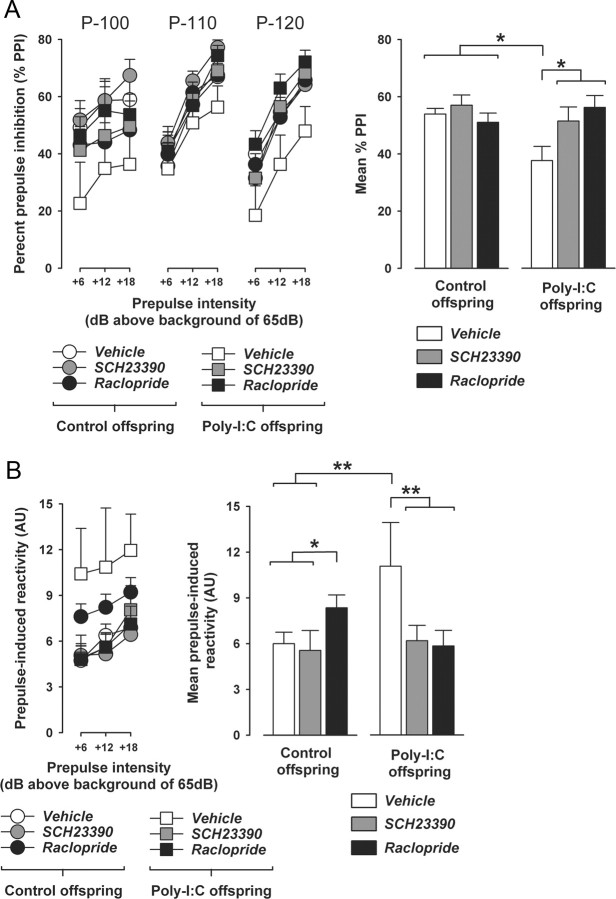Figure 11.
Effects of pharmacological dopamine D1 or D2 receptor blockade on prepulse inhibition and prepulse-induced startle reactivity in adult offspring born to immune-challenged or control mothers. The line plots show %PPI as a function of the three intensities of prepulse (71, 77, and 83 dBA, which corresponded to 6, 12, and 18 dBA above background white noise, respectively) and of the three intensities of pulse (P-100, P-110, and P-120, which corresponded to pulse intensities of 100, 110, and 120 dBA, respectively). The bar plots present mean %PPI across all prepulse and pulse levels used. A, The prenatal Poly-I:C-induced impairment in PPI was normalized by acute administration of the preferential dopamine D1 receptor antagonist SCH23390 (1 mg/kg, s.c.) or by the preferential dopamine D2 receptor antagonist raclopride (3 mg/kg, i.p.). *p < 0.05, based on Fisher's LSD post hoc group comparisons following the presence of a significant (F(2,55) = 4.55, p < 0.05) prenatal treatment × drug treatment interaction in the initial 2 × 3 × 3 × 3 (prenatal treatment × drug treatment × prepulse level × pulse level) ANOVA. B, Vehicle-treated offspring born to Poly-I:C-exposed mothers displayed a significant enhancement in prepulse-induced startle reactivity [in arbitrary units (AU)] compared with vehicle-treated offspring born to control mothers. This effect of the prenatal Poly-I:C challenge was normalized by acute administration of SCH23390 (1 mg/kg, s.c.) or raclopride (3 mg/kg, i.p.). On the other hand, acute raclopride treatment significantly increased prepulse-induced startle reactivity in offspring born to control mothers. *p < 0.05 and **p < 0.01, based on Fisher's LSD post hoc group comparisons following the presence of a significant (F(2,177) = 19.73, p < 0.001) prenatal treatment × drug treatment interaction in the initial 2 × 3 × 3 (prenatal treatment × drug treatment × prepulse level) ANOVA. The numbers of offspring included were N(control offspring/vehicle) = 10, N(control offspring/SCH23390) = 10, N(control offspring/raclopride) = 10, N(Poly-I:C offspring/vehicle) = 11, N(Poly-I:C offspring/SCH23390) = 10, N(Poly-I:C offspring/raclopride) = 10. All values in A and B are means ± SEM.

